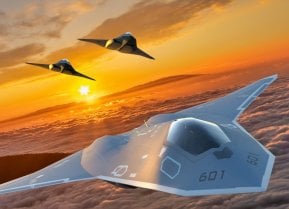Nothing Can Match the F-22 Raptor Fighter. However, Retirement Is Coming
As the first stealth fighter jet in history, the F-22 Raptor revolutionized airpower. The fifth-generation fighter combined stealth with unparalleled air superiority capabilities.
As the first stealth fighter jet in history, the F-22 Raptor revolutionized airpower. The fifth-generation fighter combined stealth with unparalleled air superiority capabilities.
The F-22 Raptor is the Air Force’s first line of defense. In a theoretical conflict with China, this fighter would be responsible for keeping the skies open for other friendly and allied aircraft.
End Is Coming for the F-22
The Raptor achieved full operational capability in 2005. The Air Force intended it to replace the F-15 Eagle fighter jet. But in fact both aircraft serve together, and there are more F-15 fighter jets than F-22 Raptors.
Now, the age of the Raptor is on the wane. Out of 186 aircraft produced by Lockheed Martin, about 130 became operational. Out of those 130 aircraft, less than 100 are likely operational today.
A recent package of upgrades might have extended its operational lifetime into the next decade, but the end is coming. The Next Generation Air Dominance program (NGAD) is under development. The Air Force wants operational capability in the early 2030s, and once the NGAD sixth-generation stealth fighter goes live, the Air Force will likely retire the F-22.
What Makes the F-22 So Strong
The aircraft’s combination of stealth, situational awareness, sensors, and maneuverability leave the F-22 nearly unmatched in air-to-air combat, even though almost two decades have passed since it entered service.
The aircraft relies on two Pratt & Whitney F119-PW-100 turbofan engines with afterburners and two-dimensional thrust-vectoring nozzles. These can produce a combined 70,000 lbs of thrust, bringing the stealth fighter to speeds of Mach 2, or about 1,500 miles per hour. What makes the F-22 Raptor especially maneuverable is its ability to use its thrust-vectoring features to change direction mid-flight. The aircraft’s moves seem to defy physics and common sense.
In terms of performance, the F-22 Raptor has an operational ceiling of 50,000 feet and a range of close to 1,900 miles, though that is achieved with the help of external fuel tanks.

The stealth fighter can combine weapons depending on its mission. For example, in a combat air patrol role, the F-22 Raptor can pack six AIM-120 AMRAAM radar-guided missiles and two AIM-9 Sidewinder heat-seeking air-to-air missiles. If the mission requires close air support of a ground unit, the stealth fighter can carry two 1,000-pound GBU-32 JDAMs or eight 250-pound SDB bombs, as well as a smaller number of air-to-air munitions.
Regardless of the mission, the F-22 Raptor can rely on its M61A2 20mm cannon (480 rounds) for close-quarters air combat or strafing ground targets. The aircraft can carry all of these munitions in internal weapons bays, thereby ensuring its stealth characteristics.

About the Author
Stavros Atlamazoglou is a seasoned defense and national security journalist specializing in special operations. A Hellenic Army veteran (national service with the 575th Marine Battalion and Army HQ), he holds a BA from the Johns Hopkins University, an MA from the Johns Hopkins’ School of Advanced International Studies (SAIS). He is pursuing a J.D. at Boston College Law School. His work has been featured in Business Insider, Sandboxx, and SOFREP.


